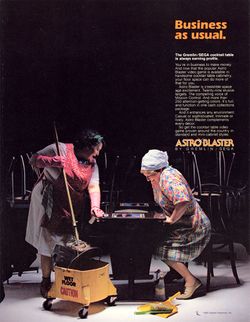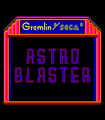Astro Blaster

| Astro Blaster | |
|---|---|
| Developer(s) | Sega |
| Publisher(s) | Sega, Gremlin |
| Year released | 1981 |
| System(s) | Arcade |
| Japanese title | アストロブラスター |
|---|---|
| Genre(s) | Shooter |
| Players | 1-2 |
| Modes | Single player, Multiplayer |
Astro Blaster is a vertical scrolling shooter arcade game, released by Sega in 1981, and licensed to Gremlin Industries for U.S. manufacture and distribution; it was the first title to run on that company's then-new "G80 Raster" hardware (a Zilog Z80 running at 3.86712 MHz with an Intel I8035 running at 3.12 MHz). The player must use two buttons to direct a spaceship left and right across the bottom of the screen (it cannot move vertically or diagonally) with two additional buttons to make it fire shots at the enemies and "warp" - and as the ship fires, its laser temperature will rise, but when it stops firing, it will return to normal. If the ship's laser temperature overheats, it will lose its ability to fire until it has returned to normal; when the "warp" button is pressed any enemies (and shots) that are currently on the screen will get slowed down for ten seconds. The player only gets one warp per life, but will gain one every time it docks with the mother ship (if it hasn't used the current one) - however, if your ship should crash into the mother ship (or runs out of fuel), the game will immediately be over regardless of how many lives you have remaining. The fuel gauge is the main hindrance for this game; as your ship flies through each sector, its fuel will decrease and if you do not have enough to make it all the way to the mother ship, you cannot win. The only way to gain extra fuel apart from docking with the mother ship is by shooting the red fireballs in the asteroid belts - and the amount of points you gain for killing enemies will also get doubled, while your fuel is "critically low". There are also twenty-five secret bonuses that a player can receive by performing certain actions; finally, in Shenmue (1999), the game's cabinet is present in the YOU Arcade in Dobuita, but it has an "Out Of Order" sign on it.
-
Title screen.
-
Upright arcade cabinet.
-
First sector of the game.



